Qiming Hu
NTIRE 2025 Image Shadow Removal Challenge Report
Jun 18, 2025Abstract:This work examines the findings of the NTIRE 2025 Shadow Removal Challenge. A total of 306 participants have registered, with 17 teams successfully submitting their solutions during the final evaluation phase. Following the last two editions, this challenge had two evaluation tracks: one focusing on reconstruction fidelity and the other on visual perception through a user study. Both tracks were evaluated with images from the WSRD+ dataset, simulating interactions between self- and cast-shadows with a large number of diverse objects, textures, and materials.
Text-Aware Real-World Image Super-Resolution via Diffusion Model with Joint Segmentation Decoders
Jun 05, 2025Abstract:The introduction of generative models has significantly advanced image super-resolution (SR) in handling real-world degradations. However, they often incur fidelity-related issues, particularly distorting textual structures. In this paper, we introduce a novel diffusion-based SR framework, namely TADiSR, which integrates text-aware attention and joint segmentation decoders to recover not only natural details but also the structural fidelity of text regions in degraded real-world images. Moreover, we propose a complete pipeline for synthesizing high-quality images with fine-grained full-image text masks, combining realistic foreground text regions with detailed background content. Extensive experiments demonstrate that our approach substantially enhances text legibility in super-resolved images, achieving state-of-the-art performance across multiple evaluation metrics and exhibiting strong generalization to real-world scenarios. Our code is available at \href{https://github.com/mingcv/TADiSR}{here}.
MODEM: A Morton-Order Degradation Estimation Mechanism for Adverse Weather Image Recovery
May 23, 2025Abstract:Restoring images degraded by adverse weather remains a significant challenge due to the highly non-uniform and spatially heterogeneous nature of weather-induced artifacts, e.g., fine-grained rain streaks versus widespread haze. Accurately estimating the underlying degradation can intuitively provide restoration models with more targeted and effective guidance, enabling adaptive processing strategies. To this end, we propose a Morton-Order Degradation Estimation Mechanism (MODEM) for adverse weather image restoration. Central to MODEM is the Morton-Order 2D-Selective-Scan Module (MOS2D), which integrates Morton-coded spatial ordering with selective state-space models to capture long-range dependencies while preserving local structural coherence. Complementing MOS2D, we introduce a Dual Degradation Estimation Module (DDEM) that disentangles and estimates both global and local degradation priors. These priors dynamically condition the MOS2D modules, facilitating adaptive and context-aware restoration. Extensive experiments and ablation studies demonstrate that MODEM achieves state-of-the-art results across multiple benchmarks and weather types, highlighting its effectiveness in modeling complex degradation dynamics. Our code will be released at https://github.com/hainuo-wang/MODEM.git.
EmotiveTalk: Expressive Talking Head Generation through Audio Information Decoupling and Emotional Video Diffusion
Nov 23, 2024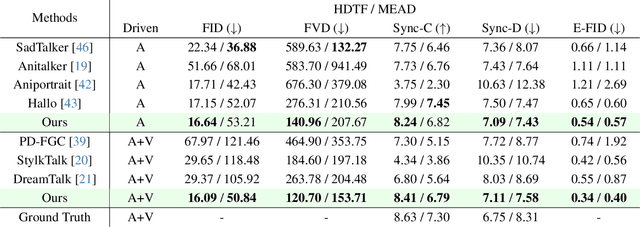
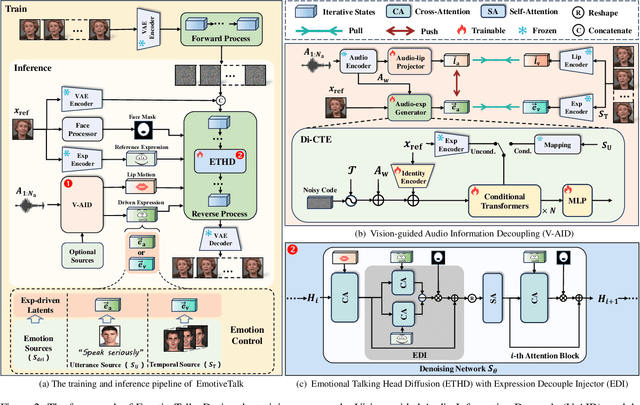


Abstract:Diffusion models have revolutionized the field of talking head generation, yet still face challenges in expressiveness, controllability, and stability in long-time generation. In this research, we propose an EmotiveTalk framework to address these issues. Firstly, to realize better control over the generation of lip movement and facial expression, a Vision-guided Audio Information Decoupling (V-AID) approach is designed to generate audio-based decoupled representations aligned with lip movements and expression. Specifically, to achieve alignment between audio and facial expression representation spaces, we present a Diffusion-based Co-speech Temporal Expansion (Di-CTE) module within V-AID to generate expression-related representations under multi-source emotion condition constraints. Then we propose a well-designed Emotional Talking Head Diffusion (ETHD) backbone to efficiently generate highly expressive talking head videos, which contains an Expression Decoupling Injection (EDI) module to automatically decouple the expressions from reference portraits while integrating the target expression information, achieving more expressive generation performance. Experimental results show that EmotiveTalk can generate expressive talking head videos, ensuring the promised controllability of emotions and stability during long-time generation, yielding state-of-the-art performance compared to existing methods.
Reversible Decoupling Network for Single Image Reflection Removal
Oct 10, 2024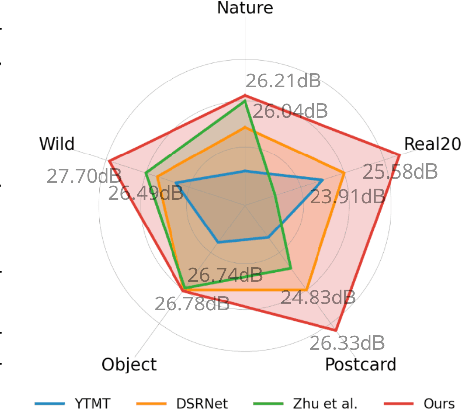
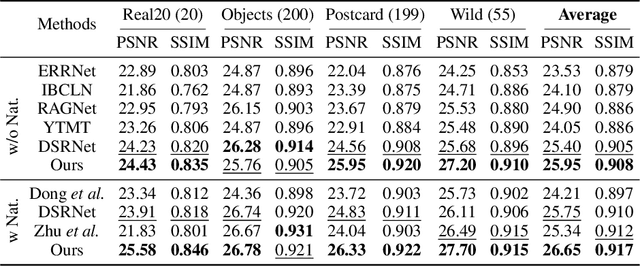
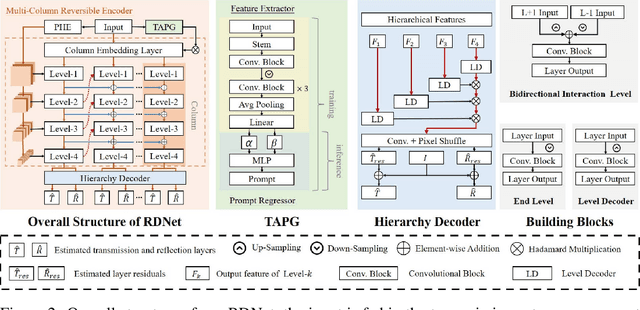

Abstract:Recent deep-learning-based approaches to single-image reflection removal have shown promising advances, primarily for two reasons: 1) the utilization of recognition-pretrained features as inputs, and 2) the design of dual-stream interaction networks. However, according to the Information Bottleneck principle, high-level semantic clues tend to be compressed or discarded during layer-by-layer propagation. Additionally, interactions in dual-stream networks follow a fixed pattern across different layers, limiting overall performance. To address these limitations, we propose a novel architecture called Reversible Decoupling Network (RDNet), which employs a reversible encoder to secure valuable information while flexibly decoupling transmission- and reflection-relevant features during the forward pass. Furthermore, we customize a transmission-rate-aware prompt generator to dynamically calibrate features, further boosting performance. Extensive experiments demonstrate the superiority of RDNet over existing SOTA methods on five widely-adopted benchmark datasets. Our code will be made publicly available.
Diag2Diag: Multi modal super resolution for physics discovery with application to fusion
May 09, 2024Abstract:This paper introduces a groundbreaking multi-modal neural network model designed for resolution enhancement, which innovatively leverages inter-diagnostic correlations within a system. Traditional approaches have primarily focused on uni-modal enhancement strategies, such as pixel-based image enhancement or heuristic signal interpolation. In contrast, our model employs a novel methodology by harnessing the diagnostic relationships within the physics of fusion plasma. Initially, we establish the correlation among diagnostics within the tokamak. Subsequently, we utilize these correlations to substantially enhance the temporal resolution of the Thomson Scattering diagnostic, which assesses plasma density and temperature. By increasing its resolution from conventional 200Hz to 500kHz, we facilitate a new level of insight into plasma behavior, previously attainable only through computationally intensive simulations. This enhancement goes beyond simple interpolation, offering novel perspectives on the underlying physical phenomena governing plasma dynamics.
Single Image Reflection Separation via Component Synergy
Aug 19, 2023Abstract:The reflection superposition phenomenon is complex and widely distributed in the real world, which derives various simplified linear and nonlinear formulations of the problem. In this paper, based on the investigation of the weaknesses of existing models, we propose a more general form of the superposition model by introducing a learnable residue term, which can effectively capture residual information during decomposition, guiding the separated layers to be complete. In order to fully capitalize on its advantages, we further design the network structure elaborately, including a novel dual-stream interaction mechanism and a powerful decomposition network with a semantic pyramid encoder. Extensive experiments and ablation studies are conducted to verify our superiority over state-of-the-art approaches on multiple real-world benchmark datasets. Our code is publicly available at https://github.com/mingcv/DSRNet.
Low-light Image Enhancement via Breaking Down the Darkness
Nov 30, 2021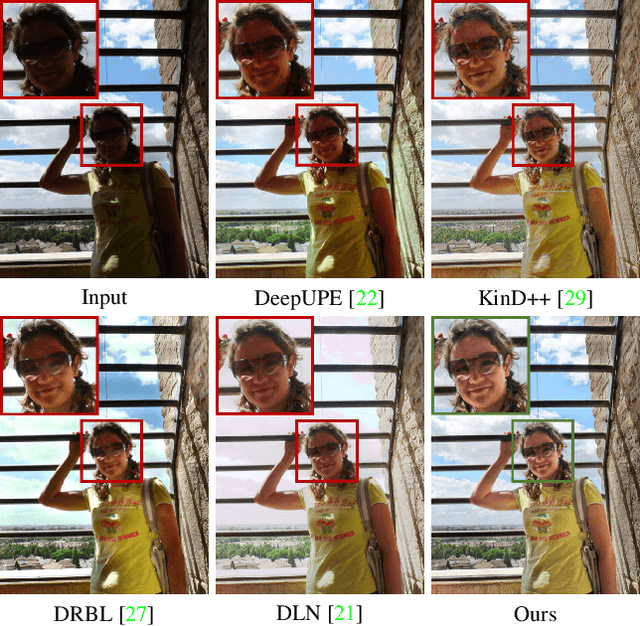


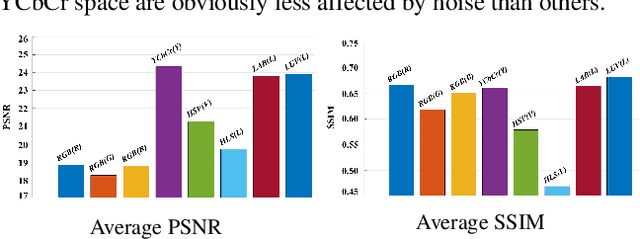
Abstract:Images captured in low-light environment often suffer from complex degradation. Simply adjusting light would inevitably result in burst of hidden noise and color distortion. To seek results with satisfied lighting, cleanliness, and realism from degraded inputs, this paper presents a novel framework inspired by the divide-and-rule principle, greatly alleviating the degradation entanglement. Assuming that an image can be decomposed into texture (with possible noise) and color components, one can specifically execute noise removal and color correction along with light adjustment. Towards this purpose, we propose to convert an image from the RGB space into a luminance-chrominance one. An adjustable noise suppression network is designed to eliminate noise in the brightened luminance, having the illumination map estimated to indicate noise boosting levels. The enhanced luminance further serves as guidance for the chrominance mapper to generate realistic colors. Extensive experiments are conducted to reveal the effectiveness of our design, and demonstrate its superiority over state-of-the-art alternatives both quantitatively and qualitatively on several benchmark datasets. Our code is publicly available at https://github.com/mingcv/Bread.
Trash or Treasure? An Interactive Dual-Stream Strategy for Single Image Reflection Separation
Oct 20, 2021



Abstract:Single image reflection separation (SIRS), as a representative blind source separation task, aims to recover two layers, $\textit{i.e.}$, transmission and reflection, from one mixed observation, which is challenging due to the highly ill-posed nature. Existing deep learning based solutions typically restore the target layers individually, or with some concerns at the end of the output, barely taking into account the interaction across the two streams/branches. In order to utilize information more efficiently, this work presents a general yet simple interactive strategy, namely $\textit{your trash is my treasure}$ (YTMT), for constructing dual-stream decomposition networks. To be specific, we explicitly enforce the two streams to communicate with each other block-wisely. Inspired by the additive property between the two components, the interactive path can be easily built via transferring, instead of discarding, deactivated information by the ReLU rectifier from one stream to the other. Both ablation studies and experimental results on widely-used SIRS datasets are conducted to demonstrate the efficacy of YTMT, and reveal its superiority over other state-of-the-art alternatives. The implementation is quite simple and our code is publicly available at $\href{https://github.com/mingcv/YTMT-Strategy}{\textit{https://github.com/mingcv/YTMT-Strategy}}$.
 Add to Chrome
Add to Chrome Add to Firefox
Add to Firefox Add to Edge
Add to Edge